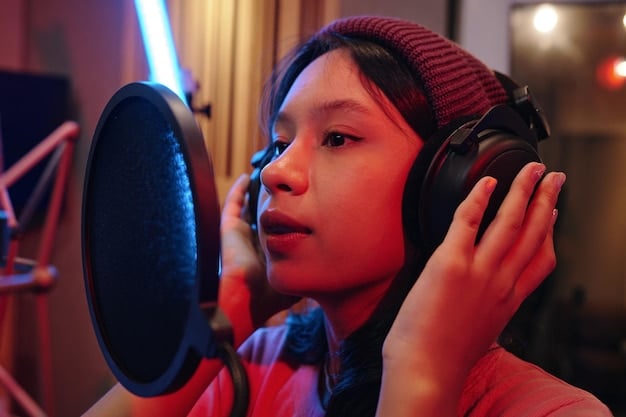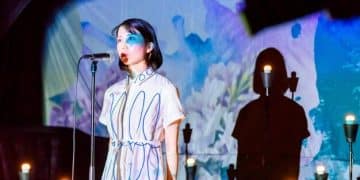K-Pop Vocal Techniques: A Guide to Unique Artist Styles

K-Pop vocal techniques are diverse and essential to understand the unique styles of K-Pop artists, setting them apart through specialized training and performance qualities that define the K-Pop sound.
K-Pop’s global appeal isn’t just about catchy tunes and stunning visuals; it’s deeply rooted in the exceptional vocal abilities of its artists. Understanding K-Pop vocal techniques allows listeners to appreciate the artistry and rigorous training that goes into crafting the distinct sound of their favorite groups.
Understanding K-Pop Vocal Training
The journey of a K-Pop vocalist is marked by rigorous training designed to hone their natural talents. This training is comprehensive, covering various aspects of vocal performance and technique to produce polished and versatile vocalists.
Systematic Vocal Coaching
K-Pop trainees undergo intense vocal coaching that focuses on developing correct posture, breathing techniques, and vocal projection. This coaching aims to prevent vocal strain and maximize vocal power.
Diverse Repertoire Training
Artists learn a range of songs across different genres. This broad exposure enhances their ability to adapt and master various vocal styles. It encourages stylistic flexibility.

Here are some key components in K-Pop vocal training:
- Breathing Exercises: Training diaphragmatic breathing ensures vocalists can sustain notes and phrases without running out of breath.
- Pitch Accuracy: A focus on hitting precise notes is critical for harmonic performances.
- Vocal Range: Expanding the vocal range allows for exploring a wider array of melodies and styles.
- Diction Training: Articulation is essential for delivering clear and crisp vocals, even at faster tempos.
K-Pop vocal training is designed to create well-rounded performers. It aims to equip them with not only technical skills but also the artistic ability to deliver engaging performances.
The Use of Vocal Techniques in K-Pop
Various vocal techniques are employed in K-Pop to enhance the musical landscape, giving each artist a distinctive edge. These techniques not only highlight technical proficiency but also serve to engage listeners and add emotional depth to the music.
Vocal Agility
A crucial aspect of K-Pop vocals is the ability to transition smoothly between notes and rhythms. This agility allows artists to navigate complex melodies and arrangements with ease.
Emotional Expression
Vocalists use dynamics, timbre, and embellishments to convey emotions vividly. This helps to connect with the audience on a deeper level.
Consider the following examples of how vocal techniques are utilized:
- Vibrato: It imparts warmth and depth, enriching sustained notes.
- Runs: Displaying runs demonstrates skill and adds flair to performances.
- Belting: Allows power and projection, especially in climactic moments.
- Falsetto: Adds delicacy and airiness, providing tonal contrast.
In K-Pop, these vocal techniques are applied thoughtfully and creatively. They enhance performance quality and ensure a unique auditory experience for all listeners.

Identifying Distinct Vocal Styles in K-Pop
Identifying vocal styles in K-Pop enhances the appreciation of musical diversity. Identifying distinctive characteristics allows listeners to discern the nuances that set each artist apart.
Range and Tone
An artist’s vocal range—from the lowest to the highest accessible note—directly influences the type of songs they can perform. This also influences the emotional colors they can convey.
Delivery Techniques
Vocal delivery involves everything from articulation to rhythm, all of which mark an artist’s signature on a song. Each artist’s delivery affects the overall song’s impact, making their presence distinct and memorable.
Distinct vocal styles can be identified by looking at key characteristics such as:
- Breathy Voices: Creates an intimate, sensual atmosphere.
- Powerful Belting: Ideal for delivering bold anthems.
- Smooth Transitions: Highlights vocal agility and precision.
- Unique Timbres: Unusual or distinctive sound qualities that make an artist instantly recognizable.
Recognizing these distinct vocal styles enriches the listening experience, allowing audiences to engage with the individuality and artistry of each K-Pop performer. It also helps fans to understand the skills and abilities of artists, fostering deeper appreciation for their craft.
The Influence of Music Production on K-Pop Vocals
In K-Pop, music production significantly shapes the presentation and impact of vocals. It’s not just about recording; it’s about crafting a sound that fits the artist’s image and enhances their vocal strengths.
Enhancing Audio Effects
Producers use layering, reverb, and compression to enrich the vocal texture, making it sit perfectly within the mix. Producers can also use pitch correction tools in order to refine an artist’s performance, achieving a polished sound.
Creative Arrangements
Arrangements help in highlighting the vocal delivery by adjusting elements like harmony, instrumentation and tempo. This can create contrast and complement various emotional shifts in music.
Consider these production techniques and their effects on K-Pop vocals:
- Harmonies: It can thicken vocals and add depth.
- Auto-Tune: It can smooth out imperfections, creating a more polished sound, that will sit perfectly within the mix.
- Vocal Chops: Adds a modern, rhythmic element, often used in hooks.
- Echo and Delay: Creates a sense of space, making key phrases stand out.
The relationship between music production and vocals is crucial in K-Pop. Producers fine-tune these elements and mold a sonic identity. It ensures audiences receive the most polished version of their favorite artists and their music.
Challenges Faced by K-Pop Vocalists
K-Pop vocalists face several challenges that test their skills and resilience. These challenges go beyond artistic expression and involve maintaining vocal health and navigating high-pressure environments.
Maintaining Vocal Health
The intensive schedules and demanding performances can take a toll on vocal cords. Protecting their voice involves proper warm-ups, cool-downs, and hydration.
Dealing with Public Scrutiny
Artists must also navigate the high expectations and opinions of the public. Handling scrutiny requires mental and vocal resilience.
Here are some specific struggles that K-Pop vocalists encounter:
- Overuse Injuries: Extended practice and performances can lead to vocal strain and damage.
- Constant Travel: Air travel and varied climates can affect hydration and vocal cord health.
- Performance Stress: Pressure to perform flawlessly in front of large audiences can cause tension and impact vocal quality.
- Language Barriers: Singing or performing in multiple languages requires additional training and can affect pronunciation and clarity.
Addressing these challenges requires a holistic approach that includes professional training, proper self-care and mental fortitude.
How to Appreciate K-Pop Vocals More Deeply
Appreciating K-Pop vocals more deeply involves understanding the technical skills, emotional depth, and cultural influences embedded in the music. Knowledge enhances the listening experience in a holistic way.
Understanding Vocal Techniques
Familiarize the most common techniques utilized in K-Pop, such as vibrato, belting, and harmonies. Knowing these techniques will make it easier to recognize and appreciate the skills involved.
Engage with Content
Engage with commentary, analysis, and vocal covers to gain insights into individual K-Pop artist’s styles and skills. Learning more will certainly enrich the listening experience.
Here are some ways to improve your appreciation for K-Pop vocals:
- Attend Live Performances: Experiencing live shows let appreciators see the dynamics and emotion an artist puts into their performance.
- Explore Different Genres: Listen to K-Pop adjacent genres (i.e., ballads, R&B) can demonstrate the nuances of an artist’s voice.
- Read Interviews: Learning about training, inspirations and challenges offer more perspective.
- Participate in Communities: Sharing thoughts and discovering from other fans help the viewer to understand the context behind artist performance.
By taking the time to listen and learn, fans can develop a richer, more fulfilling experience with K-Pop music. It allows for a deeper connection with the artistry and performers.
| Key Point | Brief Description |
|---|---|
| 🎤 Vocal Training | Systematic coaching for posture, breathing, and projection. |
| 🎶 Vocal Techniques | Use of vibrato, runs, and belting to add emotion. |
| 🎧 Music Production | Enhancing vocals through harmonies, Auto-Tune, and effects. |
| 🤕 Challenges | Maintaining vocal health amid demanding schedules. |
Frequently Asked Questions
▼
K-Pop vocal training is exceptionally comprehensive, focusing on diverse techniques ranging from breath control to emotional expression, often pushing artists to master multiple genres.
▼
K-Pop artists maintain their vocal health through consistent warm-ups, proper hydration, and dedicated cool-down routines, all while balancing rigorous performance schedules and travel demands.
▼
Production dramatically enhances K-Pop vocals, refining their sound through harmonies, effects, and precise mixing, crafting polished performances that meet the industry’s high standards.
▼
Yes, with practice and a trained ear, individuals can distinguish various K-Pop vocal styles by observing techniques like vibrato, diverse range, and unique tones.
▼
Deeper appreciation comes with studying techniques, attending shows, and engaging in community discussions, enhancing your understanding of artist style and effort gone into craft.
Conclusion
Exploring K-Pop vocal techniques offers a new, richer way to enjoy the artistry behind the music. Becoming more aware of the training involved, different styles and the challenges that artists face enhances the overall experience. By recognizing the skills and creativity embedded in K-Pop, fans can appreciate their favorite stars at a completely different level.





